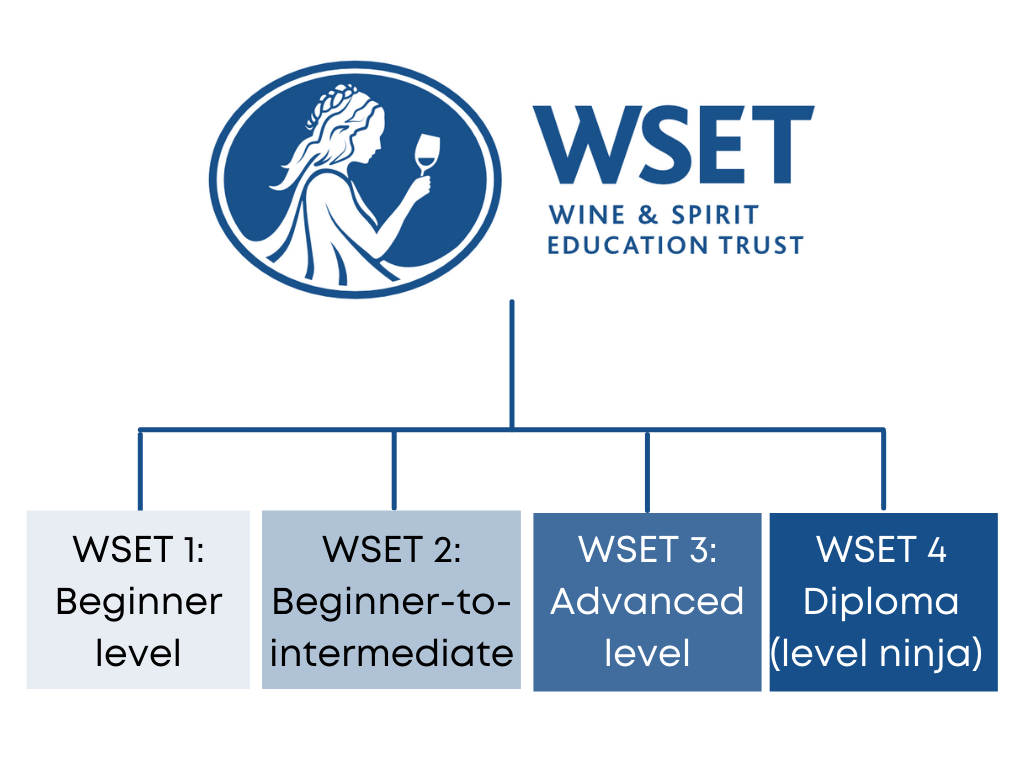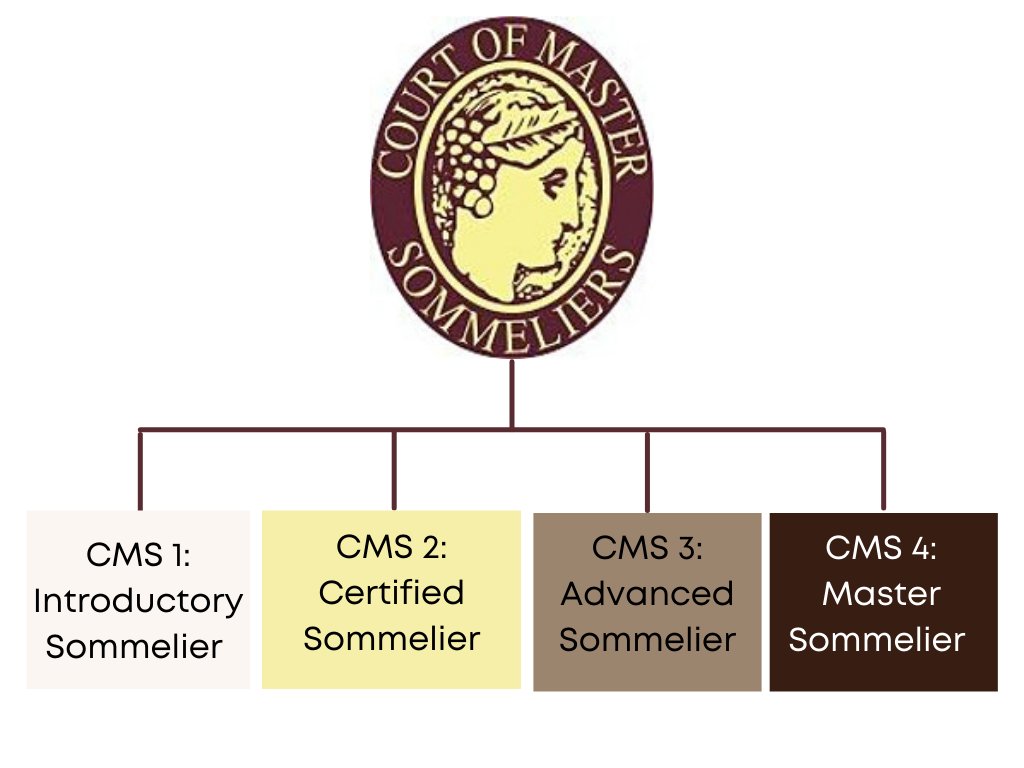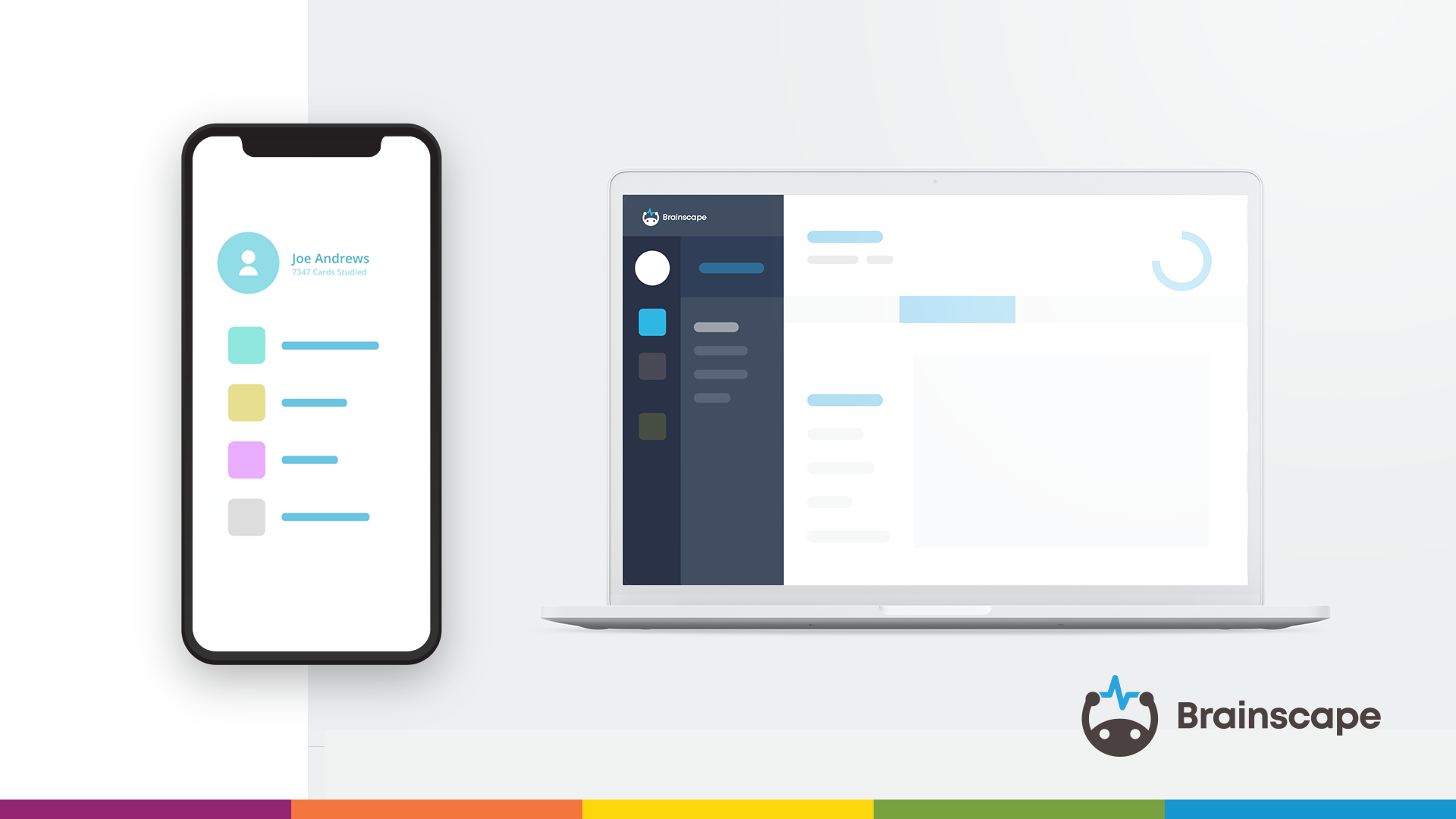If you’re a serious wine aficionado or have dabbled in the industry professionally, chances are that ‘WSET’ and ‘CMS’ will be familiar acronyms to you. The Wine & Spirits Education Trust (WSET*) and Court of Master Sommeliers (CMS*) are two of the world’s most respected wine education institutions, both of which offer a four-tiered program of courses and examinations.
Running the gauntlet of either of these will hone your knowledge and skills to a samurai sword edge. However, not everyone has the same goals for their wine education ...
- Some wish to learn the basics of wine so they can impress a date,
- Others aspire to become professional sommeliers,
- Some want to further their wine knowledge to become better servers, bartenders, wine journalists, salespeople, and marketers, for example
- Others want to take it all the way by qualifying as a Master Sommelier, which is such a lofty echelon within the wine industry, it’s a miracle candidates don’t suffer from altitude sickness.
Whichever way you want to go, the starting point is pretty much the same for everyone. And it kicks off with the following question: “What’s the difference between the sommelier levels and wine certifications offered by the WSET and CMS?”
That, my friends, is exactly what we’ll be answering in this guide with the help of Brainscape’s experienced panel of Advanced Sommeliers and wine experts!
[If you’re as geeky about wine as we are, join our Wine Community in Discord where we share all of our coolest facts, food pairing tips, wine life hacks, trivia, and so much more. Here, you can chat to other wine nerds from around the world and just generally live your best wine life!]
What’s covered in this WSET vs CMS guide

We’ll begin with a detailed breakdown of the WSET wine certifications and CMS sommelier levels, peppering our discovery with some fantastic resources and tools you can use to better prepare for these demanding examinations.
If you’d prefer to skip this information, you can head straight on over to the main event: the WSET vs CMS battle; although the goal won’t be to establish a victor. You can’t compare apples with oranges. Rather, our aim is to help you choose a course of education that best suits your specific goals.
And, finally, we’ll end off with how Brainscape—the world’s smartest flashcard app—can help you successfully tackle the mountains of information you need to learn on your wine journey. Our ready-made, expert-curated flashcards for the WSET 1, WSET 2, WSET 3, and CMS 1 are used by tens of thousands of wine students all over the world, who say that we’ve made their studying way more efficient and lives infinitely easier!
Now that you know what to expect, let’s get started ...
The WSET wine certifications

Established in 1969—in the same year as the moon landing—the Wine & Spirits Education Trust is the largest global provider of wine, spirits, and sake qualifications, designed for anyone with an interest in wine, whether personal or professional.
They offer a four-tiered program of educational courses and examinations, starting with the beginner Level 1 and beginner-to-intermediate Level 2 Awards in wine, progressing through the Level 3 for advanced wine students, and culminating in the prestigious Level 4 Diploma.
The WSET also offers Level 1, 2, and 3 certifications in spirits and Level 1 and 3 in sake (Japanese rice wine), but those are separate from the wine certification levels and so we won’t pay them much attention in this guide.
Who is the WSET for?
Simply put: anyone with a love for wine. Or at the very least, a compelling reason to learn more about it (and that reason is very rarely NOT love). As such, a huge diversity of people sign up for WSET wine certifications, including:
- General wine enthusiasts who want to learn more so that they can make smarter buying decisions and food pairing choices.
- Business professionals who are required to “wine and dine” clients as a part of their working day (tough job) and who want to impress with their selections.
- Foodies / practitioners of the culinary arts whose lives revolve around what’s on the menu. And since food and wine are undeniably in love and cannot be torn asunder, it behooves these folks to be wine educated.
- Serious wine lovers who want to get a job or advance their careers in the wine and/or hospitality industries. This includes wine buyers, marketers, retailers, and collectors.
If you fall into any of these categories—and I’d bet my boots you do—the WSET wine certifications are definitely for you.
But of the four qualifications, which one will suit your ambitions? And how far do you need to take your education to fulfill your goals?
Let’s take a look …
Psst: We have the perfect guide for you if you're looking for a job as a wine sommelier.
How are WSET wine levels structured?
- WSET Level 1 wine certification
- WSET Level 2 wine certification
- WSET Level 3 wine certification
- WSET Level 4 Diploma

The WSET offers its courses in a classroom or online with official WSET course providers, of which there is a truly staggering number in over 70 countries around the world. Here’s a more detailed break-down of its four wine certifications and what they entail ...
WSET Level 1 wine certification
The Level 1 Award in Wines is a one-day course (minimum requirement of six hours’ study time) that provides a sweeping, yet surface-level review of basic wine knowledge. You’ll also be introduced to the WSET’s Systematic Approach to Tasting Wine® (SAT), which is the organization’s step-by-step methodology for tasting and evaluating wines.
To pass the WSET 1: you’ll need to score 70% on a 45-minute, 30-mark, multiple-choice theory exam. There is no practical tasting exam.
Learn more about the WSET Level 1 wine certification in our guide, or even start studying today with Brainscape’s certified flashcards for the WSET 1!
WSET Level 2 wine certification
The Level 2 Award in Wines is a (minimum) 28-hour course intended for beginner-to-intermediate-level folks, taking them on a more detailed foray into the world of wine. You’ll also dive deeper into the SAT with more complex tasting notes and observations. Oh, and by the way, if you already know a little bit about wine, you can skip the WSET 1 and enroll for the WSET 2.
To pass the WSET 2: you’ll need to score 55% on a one-hour, 50-mark, multiple-choice theory exam. There is no practical tasting exam.
Learn more about the WSET Level 2 wine certification in our guide, or even start studying today with Brainscape’s certified flashcards for the WSET 2!
WSET Level 3 wine certification
Building upon what you learned in the WSET 2, the Level 3 Award in Wines delivers a significant breadth and depth of knowledge, teaching you to assess wines accurately, and use your understanding to confidently explain wine style and quality. This is a (minimum) 84-hour course intended for advanced wine students who are serious about their subject.
To pass the WSET 3: you’ll need to score 55% on TWO assessments:
- A two-hour, closed-book theory examination (Unit 1), which is broken down into 50 multiple-choice questions worth one mark each, and four short, written questions (sort of like mini-essays) worth 25 marks each, for a total of 150 marks.
- A 30-minute tasting examination (Unit 2), in which you are required to blind taste and evaluate two still wines: one red and one white.
Learn more about the WSET Level 3 wine certification in our guide, or even start studying today with Brainscape’s certified flashcards for the WSET 3. We also have some excellent tips to help you ace the practical tasting exam!
WSET Level 4 Diploma
The WSET Level 4 Diploma in Wines is an expert-level qualification covering all aspects of wine. Your knowledge will be honed to a razor’s edge both theoretically (through the comprehensive study of a large number of wine regions) and practically (by elevating your wine tasting and evaluation skills to expert level).
This is a (minimum) 500-hour course of which 370 hours should consist of personal study time and revision. To pass, you’ll need to take on FIVE exams, as well as an independent research assignment of 3,000 words:
- D1 - Wine production: 90-minute, closed-book exam of open-response questions
- D2 - Wine business: One-hour, closed-book exam of open-response questions
- D3 - Wines of the world: Intensive, two-consecutive-day theory and tasting examination featuring a two-part theory exam (one two-hour paper and one 80-minute paper) AND a two-part, three-hour (total) blind tasting exam of 12 wines.
- D4 - Sparkling wines: 90-minute, closed-book exam of open-response questions and a blind tasting of three sparkling wines.
- D5 - Fortified wines: 90-minute, closed-book exam of open-response questions and a blind tasting of three fortified wines.
In other words: you have got to be an EPIC wine nerd to take on the WSET 4 Diploma.
Learn more about the WSET Level 4 wine certification in our complete how-to study guides for D1 Wine Production, D4 Sparkling Wines, and D5 Fortified Wines. Or even start studying today with Brainscape’s certified flashcards for the WSET Level 4 Diploma!
And now that you know what the Wine & Spirits Education Trust offers and its four wine certifications of increasing complexity and mastery, let’s cast our attention to the Court of Master Sommeliers (CMS) and its four sommelier levels.
The CMS Sommelier Levels

The Court of Master Sommeliers is a four-tiered program of educational courses and examinations that are geared at preparing students to work within the hospitality industry as certified sommeliers. This kicks off with the Introductory Sommelier Course and Exam, followed by the Certified Sommelier Exam, the Advanced Sommelier level, and finally, the Master Sommelier Diploma exam.
By this final, fourth tier of the CMS, which is notoriously difficult to pass (and not very transparent with its exact standards of assessment), candidates will have a proven mastery of the art, science, and history that supports a sommelier’s work.
The CMS also offers an intensive, one-day wine tasting workshop, which teaches the organization’s methodology for wine evaluation: the “Deductive Tasting Method”.
Who is the CMS for?
Though not restrictive, an education with the CMS is primarily targeted at individuals who want to work in the hospitality industry—restaurants, hotels, bars, luxury yacht charters, private clubs, cruise ships, or consulting—as sommeliers or wine/beverage directors.
The Introductory Sommelier level actually recommends that candidates have a minimum of three years of experience in the wine/service industry, though it’s not strictly speaking required. If you don’t have this experience, prepare to invest a lot more time in bringing your knowledge up to speed for the review course!
How are the sommelier levels/exams structured?

Level 1: Introductory Sommelier course and exam
The CMS Introductory Sommelier course and exam is an intensive two-day course that provides a wide-ranging review of wine and beverage theory knowledge, as well as the CMS’s Deductive Tasting Method.
At the end of the second day, you’ll take a 70-mark, multiple-choice exam with a pass mark of 60%. While your instruction includes blind tastings, there is no practical tasting exam.
Learn more about the CMS Introductory Sommelier level in our guide, or even start studying today with Brainscape’s certified CMS Level 1 flashcards!
Level 2: Certified Sommelier exam
The CMS Certified Sommelier is the crowning qualification you require to officially become a certified sommelier. This course develops your ability to “demonstrate proficiency in deductive tasting, wine and beverage theory, and both technical as well as salesmanship skills in table-side service”.
To pass, you’ll need to have completed the Introductory Sommelier course within the past three years and achieved a minimum of 60% on each of the exam’s three components:
- A 30-minute tasting examination (blind taste four wines)
- A 35-minute, 45-questions theory examination
- A service examination during which you’ll show off your service skills by recommending beverages, and wine pairings, opening and pouring bottles, etc.
Learn more about the CMS Certified Sommelier level in our guide, and our Brainscape certified CMS Level 2 flashcards coming soon!
Level 3: Advanced Sommelier course and exam
The CMS Advanced Sommelier course continues your steep upward learning trajectory with a deep dive into the standards in beverage sales and service (the business of wine). Once again, the expectation is that you prepare (a year is the recommended time) by studying the assigned material before attending the three-day course and examination. This will test your mastery of the following three sections with a pass mark of 60% required for all three:
- Theory (written)
- Tasting (verbals)
- Service/salesmanship (practical)
Please note that you are required to have at least three years of experience in the hospitality industry to be considered eligible for the CMS Advanced Sommelier level.
Level 4: Master Sommelier Diploma exam
The Master Sommelier Diploma is similar in format and content to that of the Advanced Sommelier level but has a pass mark of 75% (and not 60%) for its theory examination (verbal, not written), deductive tasting exam (of six wines), and practical wine service exam.
Beyond this point, things become a little opaque. The CMS doesn’t have a syllabus for its Master Sommelier Diploma and it provides NO feedback to candidates on how well they do in the final exam. All you get for grafting your arse off for several years is a: “congratulations, you passed” or a “sorry...try again next year”.
And with a pass rate of 3 to 8%, most candidates return home bewildered, frustrated, and seriously questioning their life choices.
In the absence of a transparent grading system, the Master Sommelier examiners are given god-like powers to decide the fate of candidates. And, unfortunately, these powers have been abused in the past, particularly to manipulate and sexually harass female candidates.
The final showdown: WSET vs CMS

After our epic journey through the multi-tiered wildernesses of the Wine & Spirits Education Trust and Court of Master Sommeliers, we’ve arrived at the grand crescendo: the WSET vs CMS final showdown! Here are the key differences between these two institutions’ offerings …
The CMS’s sommelier levels:
- Are primarily targeted at individuals who want to work in the hospitality industry—restaurants, hotels, bars, luxury yacht charters, private clubs, cruise ships, or consulting—as sommeliers or wine/beverage directors.
- Recommend/require that candidates have a certain number of years of hospitality experience in order to enroll.
- Are intended to be taken consecutively, with each level requiring you to have passed the previous within a certain timeframe.
- Teach students about all beverages: wine, spirits, beer, cider, and sake.
- Are more “service” oriented and so include a lot of practical training in beverage and wine service and professional tasting.
- Expect you to arrive for your class already knowing all (or most) of the material.
- Lean heavily towards self-study and so play to the strengths of independent, self-sufficient students.
The WSET wine certifications:
- Are for anyone and everyone with an interest in wine, whether for personal joy or professional aspirations (retail, marketing, education, hospitality, journalism, and more).
- Have no prerequisites to enroll, aside from being of legal drinking age, of course.
- Don’t have to be taken consecutively. As long as you can demonstrate the necessary knowledge to enroll for the way more demanding WSET 3 and 4.
- Focus exclusively on wine and do not include other beverages, although the WSET does offer separate certification levels for spirits and sake.
- Are more “communications” focused, offering a progressively detailed academic understanding of wine, with more tasting experience the further you go.
- Teach you what you need to know in class, so no preparation is really required (though it is encouraged).
- Offer a formal, in-class delivery of content, which plays to the strengths of students who prefer a more structured learning environment with time to absorb and reflect on what they learn.
Hey, Brainscape can help you with your wine education!

One of the hallmarks of BOTH the WSET and CMS programs is the large volume of information you need to learn in order to pass their exams. And this is what makes Brainscape the best study tool for the job!
With the help of our expert team of wine and beverage bosses, Brainscape has compiled certified collections of flashcards for the following prestigious courses:
- WSET Level 1 in wine
- WSET Level 1 in spirits
- CMS Introductory Sommelier
- WSET Level 2 in wine
- WSET Level 2 in spirits
- WSET Level 3 in wine
- WSET Level 3 in spirits
- WSET Level 4 Diploma Wine Production
- WSET Level 4 Diploma Sparkling Wine
- WSET Level 4 Diploma Fortified Wines
- WSET Level 4 Diploma Wine Business (coming soon!)
- WSET Level 4 Diploma Wines of the World (coming soon!)
- CMS Certified Sommelier (coming soon!)
(By the way: if you're also interested in spirits, check out our guide on everything you need to know about WSET spirits certifications.)
These ready-made, expert-curated flashcards break each course’s content down into logical bite-sized pieces, which it then poses in simple question-and-answer flashcard pairs.
As you work through these flashcards—which you can do anytime, anywhere via Brainscape’s mobile app—our fancy spaced repetition algorithm will adapt to you, repeating the cards you struggle with more frequently; while those you’re confident in get shown less often.
This is the best way to learn efficiently, review frequently, and target your weaknesses.
Moreover, studying these flashcards compels you to exercise your brain’s cognitive powers of active recall and metacognition, which are proven to help you learn quicker by forming deeper, more permanent memories of the information.
So, if you’ve boldly signed up for any of the sommelier levels and wine certifications listed above, get Brainscape in your corner and we’ll help you master facts you need to ace the exams!
A final note on the WSET wine certifications and CMS sommelier levels

While we’ve spent much of this guide comparing the programs offered by the WSET and CMS, at the end of the day, they’re very different programs for people with different career goals and/or levels of experience.
You also don’t have to pick either WSET or CMS and run with it to the end. Many wine industry folks start out with the WSET 1 and 2, progress to the CMS Introductory Sommelier level, and then take the Certified Sommelier level.
Some then push on to Advanced Sommelier and, finally, conclude with the WSET 4 Diploma, since it’s more approachable and transparent. The path you take depends entirely on you and where your passion for wine takes you.
So, the only thing left to say is that we hope you bring Brainscape along for the ride to help you rise to your challenge!
*Disclaimer: Brainscape has worked with top wine experts to supplement the official publications and preparation offered by WSET or CMS.
